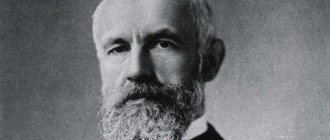Brief biography of the scientist
Wilhelm Wundt was born in 1832 into the family of a pastor. He graduated from the local school in 1851. He continued his studies at the University of Tübingen.
After receiving his diploma, he studied for a very short time with the famous German biologist Johann Muller. In 1858, he became an assistant to Hermann von Helmholtz and began giving lectures, during which he never tired of talking about the importance of using experimental methods in the study of psychology. His lectures were later compiled and published as a book, Lectures on the Mind of Man and Animals. Wundt began research that later resulted in the main work of his life, “Principles of Physiological Psychology.” In it, he described a method of studying psychology that was popular at that time - the method of introspection, thus becoming one of its founders. In 1875, Wilhelm Maximilian took up the position of professor of philosophy at the University of Leipzig. After 4 years of work, he decided to leave and founded the first psychological laboratory. (It’s interesting that one of Wundt’s students was our compatriot Ivan Pavlov.)
Wundt left behind an enormous scientific legacy - more than 50 thousand pages of articles and books.
History of the development of the method
Having understood what the term introspection means, it is necessary to say who is the author of the introspection method.
Introspection as a method of scientific research owes its appearance to R. Descartes and J. Locke. These philosophers viewed introspection as a special type of cognition.
Synonymous approaches can be found in F. Brentano, who used the method of internal observation in his experimental activities.
The followers of the ideas of the founders of introspection were W. Wundt, E. Titchener and the entire Würzburg school of psychology. Wundt combined introspection with laboratory experiment and different ways of conducting it.
Later, in Gestalt psychology, this type of study of one’s own inner world took the form of phenomenological introspection.
In the 19th century, the method of introspection was used as a term to refer to the subjective experiences of participants in psychological studies. This means that scientists made conclusions about certain psychological events and phenomena based not on their own introspective feelings, but on the basis of a report on the subjects’ introspection.
The method of introspection was seriously criticized by behaviorists, who argued that only the externally observable behavioral reactions of individuals can serve as evidence of certain psychological manifestations. Proponents of self-observation were reproached for the lack of objectivity of their method.
In this regard, the original concept underwent some changes: now the participant in the experiment was only required to answer the question asked and report the changes that had occurred by pressing a special button. With the help of these transformations, it was possible to move away from subjectivism in introspection.
The schools of objective and cognitive psychology that formed a little later were opponents of introspection due to the low objectivity of the method. Specialists in these areas argued that it is possible to obtain reliable information about a person through specially organized third-party surveillance.
At the beginning of the 20th century, introspection was recognized as an unscientific, idealistic method whose main problem was its lack of objectivity. But at the same time, it was used in the study of the inner world and spiritual attitudes of the individual, and was traced in the reflective moments of psychological and pedagogical experiments.
We can say with confidence that a method such as introspection is also used in modern psychology. For example, in the methodological literature there is a mention of the practical application of self-observation techniques in humanistic and transpersonal psychology to monitor an individual’s changes in the course of his own thoughts and the formation of moral attitudes.
Contributions to the study of psychology
Wilhelm Wundt became one of the first preachers of experimental psychology. He made human consciousness - its contents, processes and states - the main subject of his study.
The contents of consciousness, according to Wundt, include fleeting sensations, images of objects, desires, memories, emotions, etc.
Processes are divided into two types:
- Involuntary. They happen on their own. For example, when you are traveling on a train, the sound of the wheels seems to form a certain rhythm on its own.
- Arbitrary. Directed by a person. That is, if you wish, you can change this rhythm.
Also, the German psychologist was the first to introduce the concept of the volume of consciousness (the number of impressions that it can hold in itself at the same time) and concluded that this volume is not limited if the content is constantly combined into larger and larger units.
Advantages and disadvantages
Introspection has clear advantages, but, unfortunately, the listed advantages of the method do not make it ideal. And this method of psychological research has significant disadvantages:
This method is good because a person needs mainly his own help and desires. But a person must be willing to take the time to know himself.
By the way, due to the fact that the child’s psyche is not sufficiently formed, children are generally unable to carry out introspection.
Method of studying psychology
In his research, Wundt used the method of introspection (self-observation), which is rejected by modern psychology due to excessive subjectivity. What was the essence of the method? Wundt and his colleagues (specially trained in introspection) observed themselves in various situations and compiled a report in which they described how they felt and how they behaved when stimuli appeared. Here is a clear example of how the method was applied. The subject was given a large red apple. But he could not write in the report: “They gave me an apple. It was big and red." He needed to dig deeper: “First I felt the red color of the apple. Then I felt its roundness and size. Then a slight tickling sensation appeared in the tongue - apparently a trace of a taste sensation,” etc.
Since psychology was just in its infancy in those days, Wilhelm Maximilian decided to take chemistry, which had already been sufficiently studied and developed, as the basis of science. That is why his system is characterized by elementalism.
Definition
What is introspection? This term comes from the Latin introspicere, meaning “inward looking” or “internal inspection”, which encourages us to “look inside the subjective” subject, to recognize his mental, emotional, reflective states in relation to various situations, to ask for answers before events.
It interprets, reinterprets, reflects through its emotional cognitive processes in place or in the past, recalling situations that caused change or pleasure... It is the ability to observe, be present, understand and connect with our inner world and know who I am, where I am, what do I do and what do I want and need?
Almost always we allow ourselves to be carried along by the flow of the human river, but our senses act consciously to become aware of this, and it is not that we are on autopilot, trained to act without thinking, but that we are aware of our own states with intuitive thought and intelligence .
Introspection is the immediate reflective ability that the mind has in its daily activities when it is alert or conscious, which is often asleep or occupied with "distractions" from consumption or the production market, and sometimes this can seem like a soundtrack. But we are the most developed and beautiful in the evolutionary chain.
In psychology, introspection is a method by which a subject describes his conscious experience in sensory, affective, or imaginative terms.
Many psychological schools have used them in different ways and in interaction with a psychologist, therapist, analyst who agrees to experimentally observe the activities of the subject.
Basic principles, pros and cons of the Wundt method
There are three basic principles of the Wundt method:
- Human consciousness is a collection of personal experiences that do not manifest themselves externally. Therefore, it must be studied through introspection.
- The psyche and consciousness (what is conscious) are one and the same.
- Consciousness is a certain number of elements interconnected associatively.
As for the advantages and disadvantages, the main advantage of the method was that a person, with the help of introspection, will better determine his feelings and characteristics than anyone else. And the main disadvantage of the method is bias, because a person can interpret observations to his advantage.
The problem of self-observation
In the process of numerous checks, it turned out that the self-observation method does not meet such criteria as reproducibility and the ability to accurately record results. This was explained by the fact that the participants in the experiment were ordinary people who were distracted during the experiment and did not always accurately and timely give feedback to the experimenter.
Thus, introspection was recognized not as a method of studying the mental processes themselves, but the traces that these processes leave in the human mind.
Another problem with using the method is its limitations: the results of self-observation state the fact of the presence of a sign, but do not allow it to be explained. It can only be used to explore ideas, associations and sensations.
What did the psychologist study in the laboratory?
In the 20 years since the founding of the psychological laboratory, Wundt and his students conducted more than 100 experiments. Basically, they considered those problems that had already been posed by other scientists, but were not fully studied. The first series of experiments was devoted to studying the psychological aspects of hearing, vision, smell, sense of time and other senses. Close attention was also paid to experiments studying reaction times. Wundt found that the human reaction to a stimulus can be divided into 3 stages:
- Perception of the stimulus.
- Awareness of the stimulus.
- Manifestation of will.
After exposure to a stimulus, a person perceives it, analyzes it and finally reacts. The reaction represents the movement of the muscles, and Wundt wanted to find out its average value. However, he was unable to do this, because... it was difficult to distinguish between the stages of the reaction. Another object of study by the psychologist was what we now call the focus of attention. An example of focus is the perception of the page that you now see in front of you. While you are reading one paragraph, others are not so clearly visible. Wilhelm Maximilian, among other things, wanted to take up the study of child psychology, but did not conduct experiments, because children were unlikely to be able to accurately describe their internal state and sensations.
Systematic introspection
Between 1901 and 1905 in Würzburg, under the leadership of Külpe, what became known as systematic introspection developed. Külpe, who like Titchener was influenced by Mach's positivism, moved from Leipzig to Würzburg with the conviction that experimental psychology should also study thinking. The new experimental psychology could deal with sensations, perceptions and reactions, and Ebbinghaus added memory to this list in 1885. Wundt said that thought cannot be studied experimentally. The positivist Külpe, however, was confident that all he had to do was find subjects willing to think under controlled conditions and then obtain from them an introductory report of their thinking processes.
This was followed by a brilliant series of works on associations (1901), written by Külpe's students: Mayer and Orth on judgment (1901), Marbe on feeling (1903), Watt on thinking (1905), Ach on action and thinking (1905). Each of these works argued that so-called classical introspection does not meet any of the above problems. Mayer and Orth described the chain of associated images in the process of thinking, but did not find any indication in introspection of how thinking is directed towards its goal. Marbe noted that although judgments are easily expressed in terms of images, introspection gives no indication of how or why they are formed. In Orth's research, emotions "resisted" introspective analysis, so he had to coin the controversial term "conscious attitude" to describe emotional life.
In his subjects, feelings, of course, did not appear in the form of sensations or images. Watt and Ach independently came to consistent conclusions. To make introspection more effective, Watt invented the technique of fragmentation: he divided psychological events into successive periods and examined each of them separately, thereby achieving a reduction in the amount of memory and inferences included in the introspective report. But the nature of thought remained elusive to him until he realized that the goal orientation of thought is given by a task or instruction (he called it a task that the subject accepted before the start of the thought process). Ach developed the concept of deterministic tendency as a guiding unconscious principle that directs conscious processes along a predetermined path to solving a problem. He also developed a partitioning procedure with chronoscopic control and formulated the method - systematic experimental introspection. Both the defining, essentially unconscious tendency and the conscious processes directed by it turned out to be impossible for Akha’s subjects in terms of classical introspection, i.e. in the language of sensations and images. For these vague, elusive contents of consciousness, Ach had to introduce the concept of consciousness, and his subjects learned to describe their consciousness in terms of unobservable experiences of consciousness.
Representatives of the Würzburg school believed that they had discovered a new type of psychic principle using the method of introspection, but the concept of consciousness did not achieve the status of being recognized in terms of sensation and image. Instead, they talked about the discovery of ugly thought by the Würzburg school, and many blamed it for this: the discovery is purely negative, even though thoughts are not images, but what is it? Titchener, however, believed that he knew the answer to this question. According to Titchener, the thoughts that Wurzburger speaks of are partly conscious relations, which are vague, fleeting patterns of sensations and images, partly meanings and judgments, which should be excluded from psychology because the task of studying them is not adequate to description.
W. Wundt (1832 - 1920)
The role of experiment is limited only to imparting accuracy and reliability to research results.
Wundt defined the main tasks of psychology:
1) analysis of the process of consciousness by the method of introspection;
2) identification of elements of consciousness;
3) establishing the patterns of their connection.
It is obvious that Wundt's program logically followed from empirical and associative psychology. Using the concepts of “apperception”, “association”, “experience” established in the philosophy of knowledge and believing that complex mental phenomena cannot be reduced to the sum of their constituent parts, Wundt inherited, although not in an explicit form, historically established explanatory principles.
The culture of experiment and its importance for the scientific discipline were learned by Wundt during his years of work in the laboratory of the physicist and physiologist G. Helmholtz. However, Wundt believed that the experimental method is applicable only to studies of the simplest psychological processes, but not to the study of higher mental phenomena related to language and culture, such as memory or learning. For these purposes, according to Wundt, only research techniques adopted in sociology and anthropology are applicable.
The experiment-oriented line of Wundt’s program was recorded in his works such as “Essays on the Theory of Perception” (1862) and “Foundations of Physiological Psychology” (1874), and the cultural-historical line - in the 10-volume work “Psychology of Nations” (1900-1920). It is important to note that the experimental line of Wundt’s program had an immeasurably greater impact on the emerging new discipline than the cultural-historical one (D. Schultz, S. E. Schultz 1998, pp. 93-94). This revealed the need of the emerging psychological community to develop a general scientific culture of research.
The most important role of W. Wundt in the formation of psychology as an independent scientific discipline was that it was he who organized the first specialized institutes of psychological science. In 1879, Wundt founded a scientific laboratory in Leipzig (Institute of Experimental Psychology), which conducted research and training of experimental specialists (more than 150 psychologists from 6 countries were trained), and in 1881 - the scientific journal Philosophische Studien), contrary to the name, is entirely devoted to psychological problems. Wundt also established a permanent membership in the scientific psychological community through the holding of the First International Congress of Psychology in Paris in 1889.
Introspection, proposed by Wundt as a method of psychology, was further developed in the paradigm of structural psychology, which was founded by E. Titchener (1867-1927), a successor of Wundt’s ideas in the USA.
The tasks of structural psychology were:
1) in “the decomposition of the mental state into its component parts”;
2) in establishing how these parts are connected;
3) in establishing the correspondence of the laws of the combination of these parts with the physiological organization.
It can be seen that these tasks do not contradict the tasks of psychology proposed by Wundt. The difference was that Titchener studied the structure of consciousness, abstracting from the functional role of the psyche in behavior. Titchener's most important innovation was the method of analytical introspection. In accordance with paradigmatic requirements, he strictly limited the possible content of the subject's report of introspection. Thus, it was required that the results of introspection be given in terms of elements of the structure of consciousness, but not in terms of objects of the external world or stimuli.
Titchener argued that introspection in experienced specialists is no different from external observation, characteristic of any other scientific method. He believed that although only one’s own consciousness is accessible to introspection, the results of introspection can be transferred by analogy to other people, children, primitive people, animals, the mentally ill; the researcher has only to put himself in their place. Such introspectionism, taken to the point of absurdity, clearly demonstrated the weaknesses and even the unacceptability of the introspective method in solving psychological problems.
Another blow to the method of introspection was also dealt by a follower of Wundt, O. Külpe (1862-1915), the founder and leader of the Würzburg school. His views on the method of introspection differed from Wundt's views. Wundt's introspection (like Titchener's analytic introspection) unfolded in synchrony with observed conscious experience. Külpe's systematic introspection was separated from experience by a time interval and was retrospective (from the Latin retro - back, spectare - to look). The subject solved the problem proposed to him, and then described in detail the course of mental processes during its solution. This modification of introspection, as Külpe believed, did not lead to a split into the observing and observed parts of the subject, which made it possible to apply introspection to the study of not only simple mental processes, as happened with Wundt, but also thinking. These works showed that the method of systematic introspection fails to obtain information about how a subject makes a decision; even masters of introspection were unable to note the desired dynamics of ideas.
Thus, by the end of the 19th century. it was discovered that the introspection method does not reveal the main aspects of the psyche, if only because the range of phenomena studied in psychology is not limited to the phenomena of consciousness. These circumstances alone deprive introspection of the status of a method. It is equally important that introspection can be applied only to a small number of objects corresponding to the subject of psychology. Contrary to Titchener's opinion, objects should be excluded from this population who have not formed, are impaired or lack the ability to self-observe: children, representatives of some cultures, persons with psychological and neurological lesions, persons in specific conditions (sleep, stress, involvement in responsible activity) or subject to forensic medical examination, groups and teams as the subject of psychological research, animals.
· Empathy - empathy
The use of introspection as a technique encounters an unpredictable dependence of the results of introspection on the following factors:
1) cultural affiliation of the subject;
2) the degree of mastery of self-observation, which is limited by age, language competence, etc.;
3) correlation of several internal plans when combining basic activity and introspection, which retrospective introspection does not save from;
4) the subject’s attitude towards participation in the study, his role in the relationship with the researcher, etc.
Therefore, introspection is also not a method of psychological research, but can only be considered as an inevitable condition for the use of certain psychological methods (for example, questionnaires) or an auxiliary technique for collecting empirical material (reasoning out loud when solving problems, reports from subjects).
The cultural-historical line in Wundt's research program was opposed by the understanding psychology of the historian and literary critic W. Dilthey and his follower E. Spranger. They considered the main task of psychology not to explain the laws of human mental life, but to understand it in its subjectively experienced integrity.
Psychology, from their point of view, does not belong to the cycle of natural sciences (Naturwissenschaften), such as physiology, chemistry, etc., but to the spiritual sciences (Geistwissenschaften) - the cycle of humanities, which includes, for example, history and cultural studies. Dilthey and Spranger argued that in the spiritual sciences, including psychology, the natural scientific, essentially experimental, method is not applicable. The method of the humanities should be a method of understanding, which consists in the fact that the researcher must feel into the object being studied, therefore this method is also called the method of empathy
(empathy).
Note that criticism of the introspective method generally applies to the method of understanding, since it is applicable only to a limited part of the totality of objects of study and can only concern potentially conscious phenomena. The use of the method of understanding inevitably leads to erroneous judgments, when applied to animals - to anthropomorphic descriptions (transferring human properties to other objects), in relation to children - to “adult-centrism”, in intercultural studies - to “cultural-centrism”, etc. Therefore, the recognition of the method of understanding takes psychology out of the general scientific context and conflicts with basic scientific values.
Significant changes in ideas about the subject and method of psychology were made by Z. Freud (1856-1939), who founded the paradigm of psychoanalysis. The history of psychoanalysis serves as a good illustration of the emergence and development of a paradigm, its dependence on the ideas of predecessors and its influence on successor paradigms.
The idea of unconscious mental phenomena, the unconscious, which is the subject of study of psychoanalysis, was introduced into psychology by G. W. Leibniz and developed by G. Helmholtz (the theory of unconscious inferences), as well as by G. Fechner, who believed that most mental activity does not reveal itself conscious. Other sources of psychoanalysis are neurology (the area in which Z. Freud specialized), the use of hypnosis in the treatment of hysteria by French doctors J. Charcot and P. Janet at the Salpêtrière clinic in Paris, where Freud
internship, etc.
Psychoanalysis in its developed form, before its transformation into a version of popular psychology, was aimed at the study of personality and was built in accordance with such principles as the principle of determinism (in the mechanistic version), the principle of development (and one of the most important provisions of psychoanalysis is that the stages child’s ontogenesis are recorded in the form of specific mental structures), the principle of activity, the source of which, according to Freud’s teaching, lies within the subject
Psychoanalysis abandoned introspection as a research method. To obtain initial material about deep psychological structures and processes, analysis of free associations, slips of the tongue, the specifics of forgetting, interpretation of dream retellings, etc. was used. Establishing the characteristics of deep psychological structures through the interpretation of this material is the essence of a new method, which Freud called psychoanalysis.
Note that even if the primary material is obtained using the ability of introspection, for example, when retelling dreams, then introspection does not act as a method of psychology, but only as a condition for applying the technique. The method of psychoanalysis can be considered as a distant predecessor of the method of experimental reconstruction, which, however, does not include the most important experimental component that connects it with the general scientific hypothetico-deductive method and gives it the status of a modern scientific method.
The breadth of the original psychoanalytic paradigm allowed it to differentiate into many neo-Freudian paradigms: the analytical psychology of C. Jung (1875-1961), the individual psychology of A. Adler (1870-1937), the theory of deep sources of anxiety by C. Horney (1885-1952), etc.
A radical revolution in ideas about the subject and method of psychology was accomplished by J. B. Watson (1878-1958). The date of birth of behaviorism (from the English behavior - behavior) is considered to be the publication in 1913 of the article “Psychology from the point of view of a behaviorist” (Psychology as the Behaviorist Views It) in the scientific psychological journal “Psychological Review”. From the point of view of this paradigm, psychology is an objective experimental branch of the natural sciences (Schultz D., Shultz S.E., 1998, pp. 281-293). Behaviorists reject the method of introspection and reject the idea of consciousness as a subject of psychological research, and also believe that any psychological structures and processes that are not observable by objective methods either do not exist (since their existence cannot be proven) or are inaccessible to scientific research. Therefore, critics of this paradigm often call behaviorism the theory of the “empty organism.”
The subject of psychology, from the point of view of behaviorism, is behavior, understood as a set of observable muscular and glandular reactions to external stimuli (S). The task of psychology is to identify patterns of connections between stimuli and reactions (S -> R), and the goal is to predict and control the subject’s behavior. The behavioral experiment is considered a research method in behaviorism. Behaviorists entered into controversy both with those scientists who considered introspection as a method of psychology, and with those who considered hidden mental processes and structures to be the subject of study.
Behaviorism has a rich history. First of all, these are studies conducted by animal psychologists at the end of the 19th century, the purpose of which was to prove the mechanical nature of animal behavior - quite in the spirit of the philosophical concept of R. Descartes. Thus, J. Loeb (1859-1924), proving the forced, automatic nature of the movements of insects and animals, argued that the existence of associative memory in animals makes it possible to teach them to react in a certain way to stimuli (see Chapter 6). The closest predecessor of the behaviorists was E. Thorndike (1874-1949), who developed the theory of learning using objective techniques, in particular, the original trial and error technique. Even before the paradigm of behaviorism took shape, Thorndike formulated the laws of learning - the law of effect, the law of exercise, etc. - which are traditionally included in the list of achievements of behaviorism (Modern Psychology, 1999). Thorndike also believed that psychology should study behavior. The behaviorists themselves relied in their positions on the teaching of I. P. Pavlov (1849-1936) about conditioned reflexes, although Pavlov himself believed that they misunderstood him.
Of the explanatory principles in behaviorism, the principle of determinism, its linear mechanistic version, was explicitly used. The principle of development was not used in classical radical behaviorism. Note that the greatest successes have been achieved in research on learning (Modern Psychology, 1999). The principle of activity was completely rejected, even the very concept of activity was absent from the vocabulary of behaviorists, who believed that the body is activated by stimuli that may be internal (then it only looks like activity), and these stimuli are identified by objective methods of physiology. Behaviorists adhered to a mechanistic version of the principle of integrity - elementalism.
Behaviorist criticism of introspective and depth psychology, and later cognitive psychology, did much to highlight the logical and methodological contradictions in these paradigms, but the radical line of behaviorism, supporting the idea of the “empty organism” and a mechanistic understanding of explanatory principles, did not last long. It was the idea of internal psychological structures and processes that caused a split in the ranks of behaviorism when E. Tolman formulated the main provisions of cognitive behaviorism.
The popularity of softened ideas of behaviorism, which allowed the use of the concept of consciousness, was high, and in the 1950-1960s. they were accepted in social psychology (social learning theory by J. Rotter) and personality psychology (social cognitive theory of personality by A. Bandura) (Schultz D., Schultz S.E., 1998)
Crisis of psychology (10-30s of the XX century). In the 1910-1930s. In psychology, a large number of competing incompatible and even incomparable paradigms have been formed, which have realized potentially logically possible versions of understanding the subject and method of psychology. As an example, we should compare behaviorism, the essence of which is either to deny the existence of psychological structures and processes, or to recognize their inaccessibility to scientific research, and depth psychology, which postulates the existence of such structures and processes and asserts their availability for study. This was a unique situation in the history of science. No other discipline has seen so many different paradigms collide.
Here is just an incomplete list of the actual psychological paradigms that were formed during the open crisis (their substantive characteristics see: Zhdan A. N., 1990; Petrovsky A. V., Yaroshevsky M. G., 1996; Sokolova E. E., 1995; Schultz D., Schultz S.E., 1998): behaviorism; cognitive behaviorism of E. Tolman; psychoanalysis: the teachings of Freud, Jung, Adler; Gestalt psychology; dynamic psychology; K. Levina; descriptive psychology of V. Dilthey and E. Spranger; genetic psychology by J. Piaget; cultural-historical theory of L. S. Vygotsky; various versions of activity theory: M. Ya. Basov, S. L. Rubinstein; reactology version: K. N. Kornilov and V. M. Bekhterev; psychology of attitude D. N. Uznadze.
Attempts to overcome the crisis by implementing new research programs only led to an increase in the number of competing paradigms. At the same time, various paradigms, schools and directions developed different aspects of the potential subject and the corresponding method of psychology. This position is confirmed, for example, by the possibility of hybridization of even the most polar paradigms (E. Tolman’s cognitive behaviorism combined behaviorist ideas about the role of stimuli in behavior and the concept of internal psychological structure - cognitive, or cognitive, map of the environment, denied by behaviorists) or the orientation of competing paradigms on various aspects of the subject studying - the theory of activity by L. S. Rubinstein is focused on the study of activity as a process, while the theory of activity by A. N. Leontiev is on the study of the structure of activity, which opens access to the structure of consciousness (Leontiev A. N., 1975; Rubinstein S. L., 1997).
The state of psychology in the 1910-1930s. represented only a stage of open crisis, which continues to the present day and is characterized by diversity and competition of paradigms. Only the entire set of competing paradigms as a whole corresponds to the most complete understanding of the subject and method in psychology; a productive way out of the crisis does not consist in the dominance of any one paradigm, not in the merging of logically difficult paradigms, but in the evolutionary process of the psychological community developing a consensus opinion about basic scientific values, principles, subject and method of psychology.
The current state of psychology . The structure of modern psychology as a scientific discipline represents all stages of its formation. This memory of the discipline largely determines the possibilities and ways of its development. However, if concepts are borrowed from past concepts in an unchanged form that is not consistent with the modern state of affairs in psychology, this leads to an unacceptable restoration of pre-scientific ideas about the soul as a subject of psychological research and the adoption of introspection and understanding as methods of psychology. Another consequence of this approach may be the eclecticism (mutual inconsistency of concepts borrowed from various sources) of the concepts developed on its basis, as noted by W. Wundt, who tried to combine the methods of experiment and introspection.
The strict requirements of research practice, as well as intra- and inter-paradigm criticism lead to the transformation of borrowed principles and concepts. Competition and interconnections of paradigms in psychology lead to its intensive development. There are several main directions in the development of psychological science.
1. There is a development of existing paradigms. Thus, on the basis of the theory of activity of A. N. Leontiev, psychosemantics was formed (Artemyeva E. Yu., 1999), which explores the genesis, structure and functioning of the system of meanings in the individual consciousness (Petrenko V. F., 1997), using modern methods and not resorting to the method of introspection. This line of research is focused on the study of such cultural phenomena as political consciousness, intercultural differences, etc.
2. New paradigms are emerging. So, in the 1950-1960s. Humanistic psychology was formed, the subject of study of which is the unique, holistic personality of a person. The founders of humanistic psychology are considered to be A. Maslow (1908-1980) and C. Rogers (1902-1987). This paradigm opposes, on the one hand, behaviorism with its linear mechanistic principle of determinism, and on the other, psychoanalysis, which overestimates the dependence of the individual on his past. Within the framework of humanistic psychology, the main factor determining personality is considered to be aspiration towards the future, towards the fullness of the free realization of one’s potentials, self-actualization, i.e., dominant importance is attached to the principles of integrity, goal determination, development and activity. It should be noted the genetic connection of humanistic psychology with understanding psychology, which determined the main features and fate of this paradigm. Representatives of humanistic psychology do not share the most important general scientific values and are focused exclusively on the idiographic approach; experimental studies within the framework of this paradigm were not sufficiently developed and were not used to confirm their own theoretical positions. Currently, humanistic psychology has turned into a field of practical psychology (Schultz D., Shultz S.E., 1998).
3. Various versions of explanatory principles, ideas about the subject and method of psychology are formed. For example, in the 1960-1980s. Based on the principle of integrity, which has deep historical roots, the principle of consistency is formulated. Different paradigms explore different aspects of this principle.
4. New explanatory principles are emerging. For example, the principle of subjectivity, which most fully outlines the subject and method of psychology, is going through a stage of intensive development. The adoption of this principle is associated with the emergence of the psychology of the subject (Brushlinsky A.V., 1996), which continues the line of the theory of activity of S. L. Rubinstein and the continuum genetic approach in the study of thinking. The principle of reconstruction is currently beginning to take shape as a modification of the general scientific experimental method in relation to the task of psychology of studying the structure of the subject and the processes of its actualization. These principles have potential general scientific significance.
5. The most developed paradigms expand into various branches of psychology. For example, the scope of research in cognitive psychology, which began to take shape intensively in the 1950s, has been significantly expanded. as an attempt to resist the dominance of behaviorism. The foundations of this direction were laid in the works of K. Lashley, who showed the inconsistency of the behaviorist understanding of the organization of complex behavior, N. Chomsky, devoted to the study of the deep structures of speech, and J. Miller, who estimated the volume of short-term memory (the “magic” number 7 ± 2). Currently, cognitive psychology includes studies of perception, memory, mental representations, information processing, modeling of thinking, intelligence and creativity, artificial intelligence, cognitive development of children (continuing the line of research by J. Piaget), psycholinguistics; it constituted two directions in personality psychology - cognitive (J. Kelly) and social-cognitive (A. Bandura) (Solso R. L., 1995; Kjell L., Ziegler D., 1997; Schultz D., Schultz S. E. ., 1998).
6. Connections between psychology and other disciplines are developing. Due to this, new branches of psychology are emerging, for example, in contact between psychology and linguistics, psycholinguistics was formed, with neurology, neurophysiology and psychophysiology - neuropsychology, with population genetics - genetic psychophysiology.
Kinds
Throughout the history of the development of psychology as a science, introspection has been viewed from different angles. And psychologists have identified some types of introspection:
Psychological theories and schools
The concept of introspection has been discussed for a long time. Back in ancient Greece, the philosopher Plato asked himself the question: “Why not calmly and patiently examine the foundations of our thoughts and examine them carefully to find out what these aspects are in us?”
In the early days of psychology, researchers such as Wilhelm Wundt already used the introspective method.
Since the birth of psychology as a science, a large number of different theories and methods have appeared that try to explain the analysis and study of the human psyche. Different theories and schools have focused on different aspects and methods of work:
How to improve the accuracy of the method
The process of self-analysis is quite complex and requires practice to obtain good results. It's not easy to just sit down one day and already know who you are and what you are looking for in this world. You need to learn to accept everything about yourself and not fall into this dangerous network called self-deception.
To understand the practice of self-reflection, we must first know that it is a process that requires self-care. In any situation that may arise, it is advisable to check yourself before acting impulsively and looking for quick solutions, as in most cases.
Since we have had to connect with ourselves, with our thoughts and feelings, when we are in unity with ourselves, it will be much easier for us to find a solution to any situation if we begin to deal with it with the first impulse for resolution.
Although we do not see introspection used in practice as a method in itself, we can find great influence on it in the work of many branches of psychology. Cognitive methods have also often been used, which allow therapy to be developed by assessing emotions and sensations.
Just as many of the analyzes of the psychodynamic schools were captured by introspection, this can be seen from the application of methods such as word association, which make more specific use of retrospective introspection.
Natalia Shakhova










